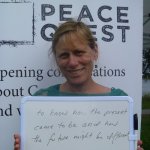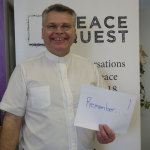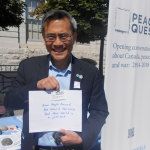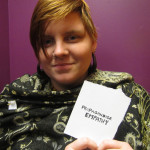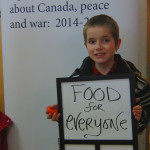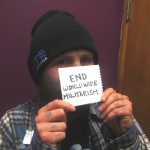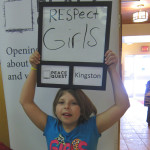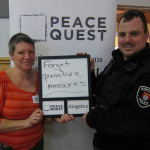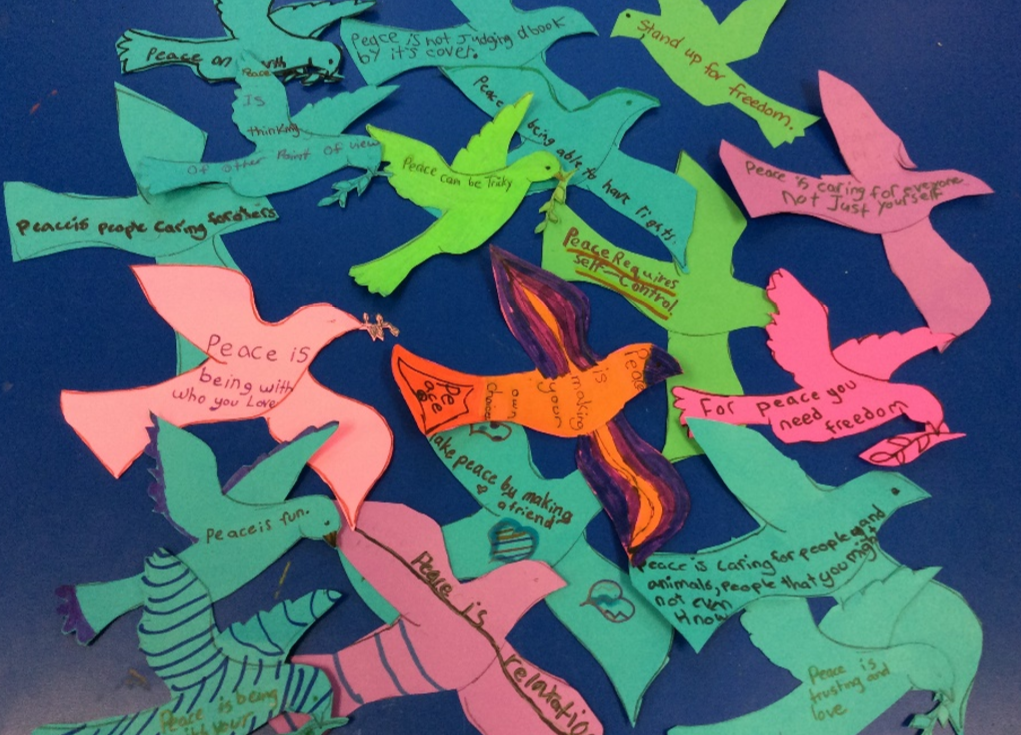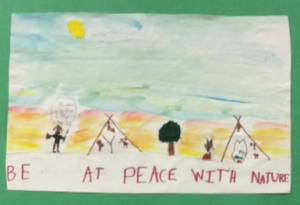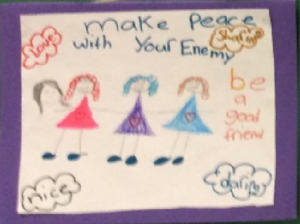Kingston classrooms getting active with PeaceQuest!
The following is a submission from a teacher in Kingston Ontario who has shared some great activities to teach peace in classrooms.
If you have teaching resources to share or would like to learn more about becoming a PeaceQuest School, please contact us!
Teaching peace (and social justice, empathy, tolerance, respect for diversity) is likely something all teachers are already doing. Here are a few new ideas for you to try with your students.
1. Open the topic overtly by asking students ” What does peace look like to you?” 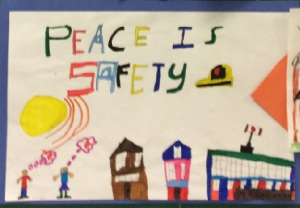
They could jot a response on a sticky note for your board. Read short articles and stories on the topic. Again, invite students to think about these, talk about these, and write in their journals about what they are learning. The Nelson collections of writing, the “Collections” reading texts and others have a variety of short pieces to share with our students. The younger grades often have writings about children trying to get along, sibling troubles, and playground problems. The grade 5 and 6 language textbooks often include articles about Peacekeeping, the United Nations and other global initiatives such as Canada’s Craig Keilberger’s work to stop child labour worldwide. Many of the older grades have texts that include articles on famous people, such as Ghandi or Nelson Mandela. Start with what’s happening with your students. You’ll know best what they need.
2. Books to jump start discussions:
There are excellent short, vivid picture books that can jump start a great discussion with older students. Please contact us to add more to our list.
Brilliant picture books:
Enemy Pie by. … If the World were a Village by… Every Human has Rights by… 14 Cows for America by… And a Tango makes Three by… (thinking about homophobia, tolerance) Fly Away Home by Eve Bunting. (Homelessness)
3. Smother your school’s foyer and halls with short quotations about peace, social justice, tolerance or environmental stewardship for a particular occasion.
It is most effective if you and your students choose some quotations and write some together on one topic, then print them on fluorescent paper and decorate the school all at once. Take them down after 3 or 4 weeks and begin planning your next blitz in a couple of months.
4. Write a letter to a government official asking for action to be taken on a social justice issue. One year, a Limestone Board class wrote the Feds to express concern for the lack of a school in Attawapiskat.
5. In February, Black History month, share a lot of readings to stimulate discussion. Don’t be afraid to learn, along with your students, that Canada’s history is not as unblemished as we once thought. Show your shock. Equally, show your pride for black Canadians’ accomplishments, and our real progress here, as a country.
6. Throughout the year, study famous peacemakers. In “shared reading”, learn about inspirational figures such as Mahatma Ghandi, Nelson Mandela, Harriet Tubman, Mother Teresa, Terry Fox, Malala Yousafzai…
7. As social justice issues appear in the news, bring them into class as literacy exercises, depending on age appropriateness.
When the military honour guard was shot in Ottawa recently, some local teachers used those two beautiful political cartoons to inspire students to create their own cartoon. The author’s goal was to persuade others that when a crisis occurs we should not act too quickly or in anger. Other examples from the news that have been used in a positive way with students from grade six up were the collapse of the garment factory in Bangladesh, the shooting of Malala Yousafzai, and the banning of a transgendered woman from the world beauty pageant.
8. Ask each student to make a poster to illustrate one of the rights in the United Nations Convention on the Rights of the Child. Find this in Child Friendly Language here.
9. Use the following writing prompt: Peace is more than the absence of war. Peace is not a NO but a YES. Write some positive statements about peace, using the framework, PEACE IS…
10. Write a letter to the world. Begin with DEAR WORLD, How would I put the world right? Without any bombs, without any fights? Conclude with That’s how I would put the world to right… and I would do it with all of my might!
11.Create a display with the following IFs.
- If you wrote a song or chant about peace, how would it go?
- If you created a recipe for peace in the world, what would the ingredients and their amounts be?
- If you were the boss of the world, how would you create peace?
- If you were asked to teach another person to be a peacemaker, what would you tell him or her?
Ask students to answer the question of their choice by creating a song, a recipe, a report, a news article, a letter, an instructional video…..
12.Teach students about three ways in which we can respond to conflict:
- with aggression (beginning a fight)
- assertiveness (standing up for our beliefs with confidence)
- submission (giving in).
Then give them problem solving scenarios which they will act out in a skit, demonstrating the three different ways of responding to a conflict. Scenarios:
- You discover your brother riding your new bike. He often takes your stuff without asking and does not treat your possessions with care. Act out the three ways that you could respond and explain which one you think is most helpful.
- You and a classmate had a fight at recess. The other student has come crying to the teacher. The teacher asks you both to sit down and settle the disagreement. Act out the three ways that you could respond and explain which one you think is most helpful.
- Your mom or dad yells at you when you make a mistake. This makes you feel stupid and angry with them. When you explain your feelings, you are told not to talk back. Act out the three ways that you could respond and explain which one you think is most helpful.
13.Brainstorm these topics with your students and write their ideas on chart paper. Refer to them often over the next few days.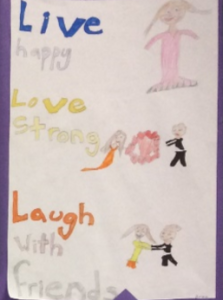
- What are some good ways to make friends?
- How does a good friend act?
- What choices can we make as kids?
- What forms of discrimination might occur on the playground?
- What should we do when we see discrimination?
- How do we feel when we are in a conflict? After the conflict?
- What are some ways to resolve a conflict?
14. Create a mind map on strife. Then create one on peace, focusing on life affirming actions.
15. Do a good deed every year with your class. Let it grow out of that group, their ideas, their experiences. One teacher, Jen Anderson, in the Limestone board, started “The
DobbyProject” after reading about how warm socks are desperately needed all winter for people experiencing homelessness. Consider a winter school sock drive for this local Kingston effort, or invite a speaker in from “Buy a Net” or another charity close to your heart that, in some way, promotes peace. After all, you can’t have peace without freedom and rights.
Here are a few photos from a local class. We would love for you to send in yours!
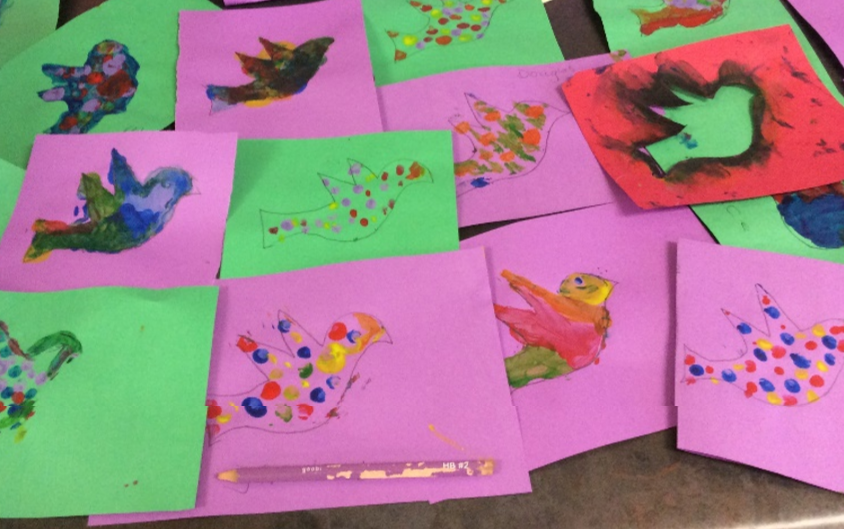 Gr. 4 students created finger painted doves to decorate a wreath for Remembrance Day, and wrote a statement about peace after several readings and discussions ….
Gr. 4 students created finger painted doves to decorate a wreath for Remembrance Day, and wrote a statement about peace after several readings and discussions ….
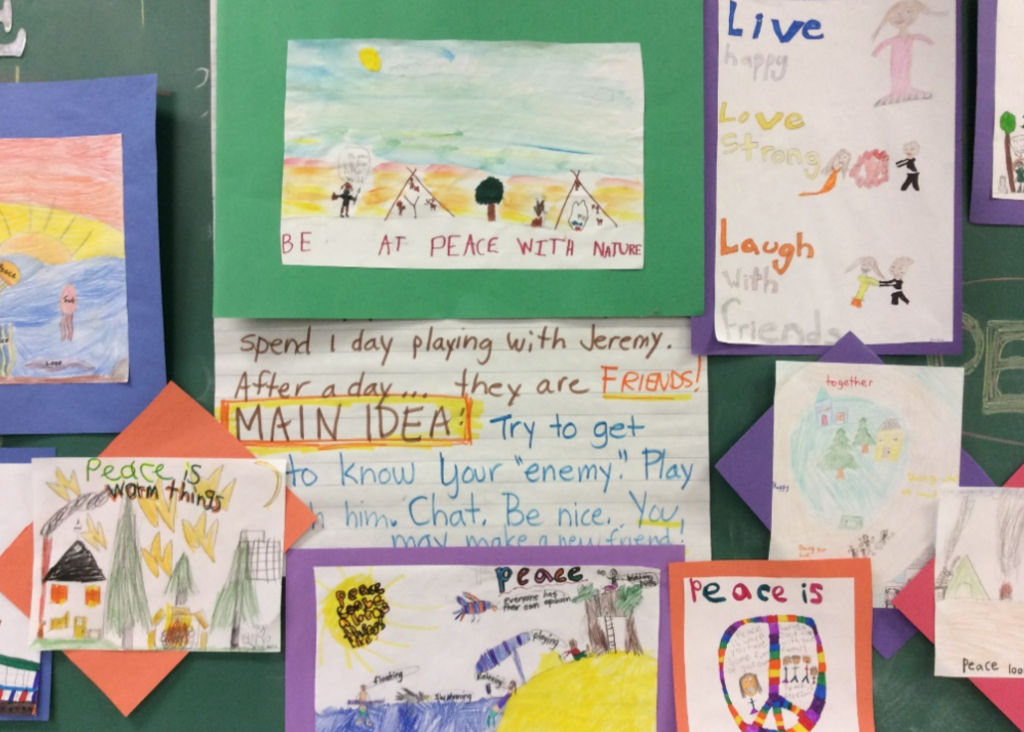
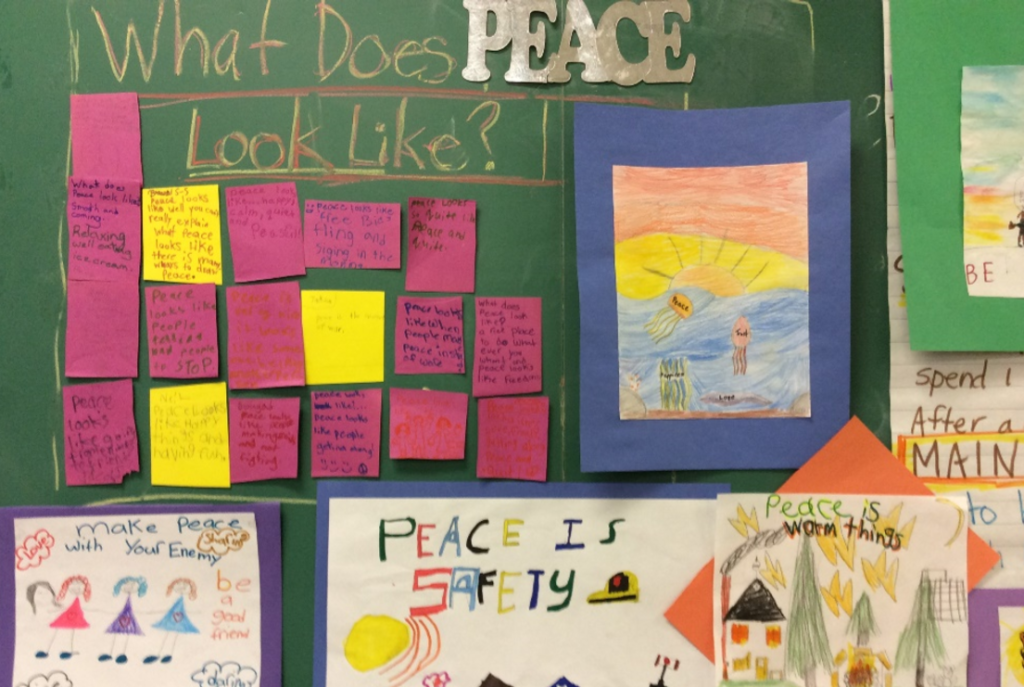
…and made posters describing what peace means to them.

This class expressed how it feels to be bullied, using a volunteer who was traced.
One teacher, Jerri Jerreat, overtly teaches world religions to grade 6 students through a series of readings during literacy classes. The class creates a very simple chart to keep them straight. The students are always surprised to learn that there are so many religions and so many ways to think of god.
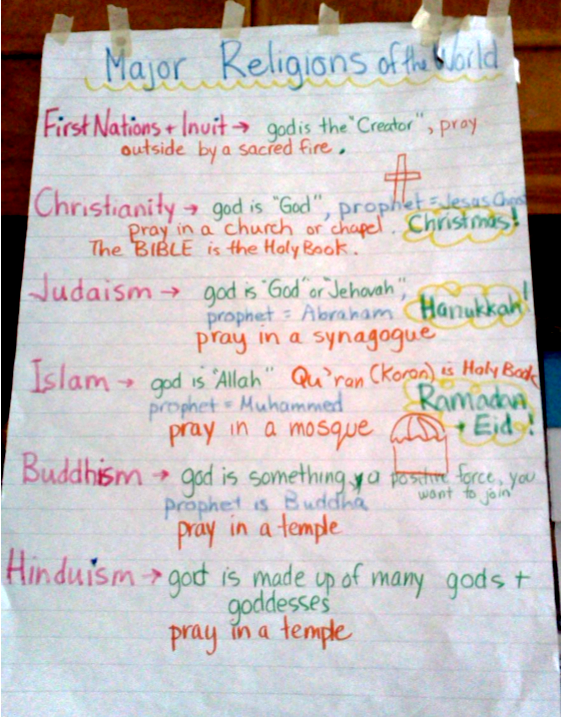
Jerri tells this interesting story:
We had a girl in our class one year, always in a pretty hijab, pink or white with lace trim, but polyester. She complained about it being so sweaty in September so I googled patterns and offered that we could try to sew her a cotton one, in her choice of colour. The students also wanted to know what it felt like to wear it all day. They suggested we have a “wear a hijab” day for class, for all the boys and girls. When I saw that their curiosity was genuine and the student seemed pleased by the idea, I told the class I would ask her parents how they would perceive it. It was important that they wouldn’t see it as disrespectful to their faith.
She brought in a hijab and kids traced it on paper. I bought light green cotton with tiny flowers, (her idea) , and the kids pinned their pattern on it and cut it out. I sewed it on the weekend (easy) and the next week, many moms sent in a plethora of jolly scarves and we had a Hijab day! Great photos. The boys and girls still played soccer, football, etc, and we had to retie the darn scarves many times, but it was kind of fun, for all of us, to walk a day in her ‘shoes’.
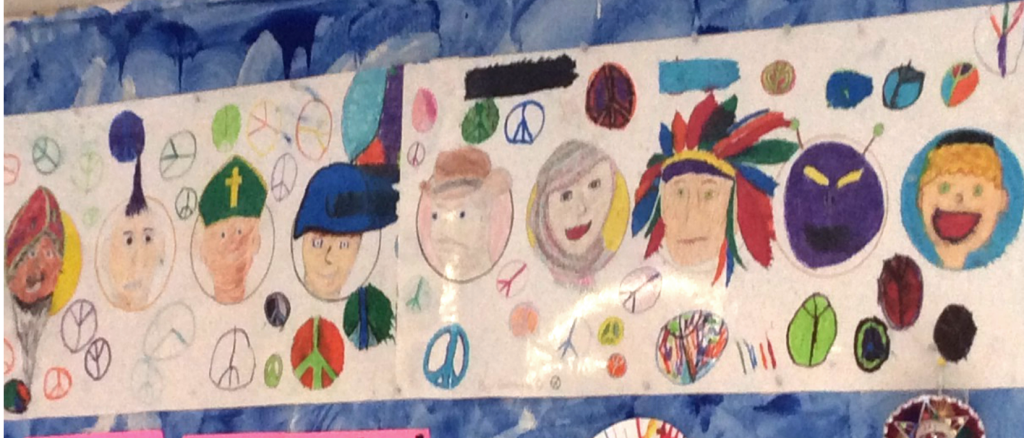 This peace mural shows the faces of people of different ethnicities and cultures.
This peace mural shows the faces of people of different ethnicities and cultures.
Local Teachers to contact:
Jerri Jerreat
You may borrow her play, “Wishing for Peace” for Remembrance Day. Approx. 10-15 minutes long). It is set in Canada in 1939, and the cast of 8 represents high school students discussing whether Canada should enter into World War II. Good with grades 5-10. If you’d like to use this play in your classroom, email her at jerreatj@limestone.on.ca
Jen Anderson (the Dobby Project) andersonj@limestone.on.ca
